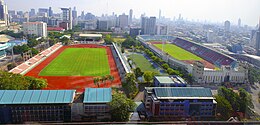National Stadium (Thailand)
This article needs additional citations for verification. (August 2014) |

The National Stadium of Thailand (Thai: สนามกีฬาแห่งชาติ or กรีฑาสถานแห่งชาติ) is a sports complex located in Pathum Wan District, Bangkok. Founded in 1937 with the construction of Suphachalasai Stadium, its main venue, the complex has since expanded and now consists of multiple stadia and sporting facilities.
History
[edit]

The stadium construction started in 1937 in the original area of Thai Windsor Palace that demolished in 1935.[1][2][3] The Department of Physical Education entered into a 29-year lease agreement with Chulalongkorn University. First use of the stadium happened when King Ananda Mahidol presided over in the opening ceremony of 1938 men's athletics competition, which changed the venue from Sanam Luang.[4][5]
Stadium Facilities
[edit]Suphachalasai Stadium
[edit]
Suphachalasai Stadium is the majority part of the National Stadium. It is the multi-purpose stadium with track and field for athletic purposes, as well as a partial roof on one of its side. With its capacity of 19,793 for sport events and 35,000 for concerts, the stadium is being used to hold important matches such as the Thai FA Cup and Thai League Cup. The stadium named after Luang Supachalasai (Bung Supachalasai), considered the Father of Thai Sport and the first Director-General of Thai Department of Physical Education.[6][7]
Thephasadin Stadium
[edit]Thephasadin Stadium was constructed in 1965 for the use in 1966 Asian Games as the Hockey venue, hence its original name, Hockey Field. It was renamed in 1983 in memory of Naga Devahastin na Ayudhya, former Acting Director-General of the Department of Physical Education.[8] With its capacity of 6,378 seats, since then the venue turned a specific football venue.
Jindarat Stadium
[edit]Jindarat Stadium, constructed after the Pacific War, was formerly used as the outdoor stadium for medium-level sporting events and practicing purposes. It was originally named Ton Pho Stadium, but was renamed in 1983 in memorial of Jindarat (Jamlong Sawat-chuto), former director of the Office of Sports and Recreation Development.
Visutdrarom Swimming Pool
[edit]Visutdrarom Swimming Pool was constructed in 1961 under the term of director Kong Visudharomn. It was the Olympic-size swimming pool with two sides of stands, used for the competition and general practices. Originally named the Olympic Pool, it was renamed in memorial of the director who organized the construction.
Nimibutr Stadium
[edit]Nimibutr Stadium, opened in 1963 is an indoor arena used for sports including boxing, badminton, gymnastics, futsal, basketball and handball.
Jhanthana-Yingyong Gymnasium
[edit]Jhanthana-Yingyong Gymnasium was built in 1965.
See also
[edit]References
[edit]- ^ "ระบบจองสนาม กรมพลศึกษา". Archived from the original on 2022-12-09. Retrieved 2021-06-12.
- ^ "สนามกีฬาแห่งชาติ ศุภชลาศัย".
- ^ ""อนุทิน-สาธิต" ใช้สบยช.-สนามกีฬาหัวหมาก-นิมิบุตร เป็นศูนย์แรกรับ-ส่งต่อผู้ป่วยโควิดไม่มีเตียง".
- ^ [1] [bare URL PDF]
- ^ "สนามศุภชลาศัย สนามกีฬาที่อยู่คู่กับวงการกีฬาไทยมากว่า 80 ปีแล้ว".
- ^ "เปิดบันทึก 'หลวงศุภชลาศัย' ตัวแทนคณะราษฎรเข้าเฝ้าร.7 ถึงกับประหม่า ขาสั่น ชาไปทั้งตัว". 17 April 2021.
- ^ "หลวงศุภชลาศัย – Seafarer Library".
- ^ "สนามเทพหัสดิน". dpeservice.dpe.go.th (in Thai). Department of Physical Education. Archived from the original on 9 December 2022. Retrieved 27 September 2023.
- National stadiums
- Sports venues in Bangkok
- Stadiums of the Asian Games
- Venues of the 1966 Asian Games
- Venues of the 1970 Asian Games
- Venues of the 1978 Asian Games
- Venues of the 1998 Asian Games
- Asian Games athletics venues
- Asian Games football venues
- Southeast Asian Games stadiums
- Sports venues completed in 1935
- Pathum Wan district
- 1935 establishments in Siam
- Property Management of Chulalongkorn University
- Asian Games water polo venues
